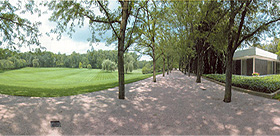|
|
 |
Reclaiming a Lost Legacy: The Challenge of Preserving the Postwar Era’s Invisible Gardens
by Charles Birnbaum
In the summer 2003 issue of Common Ground, preservationist Richard Longstreth argued that we would not question a modernist landmark’s significance were it constructed 175 years ago. Time bestows import, he wrote, and the buildings of the modern movement do not have time to wait.
This is even more true for the era’s designed landscapes. What comes to mind when preservationists talk about the great works? Usually pastoral places such as Central Park and the Golden Gate, or emblematic estates such as Biltmore or the Breakers. If a landscape is not picturesque, if it lacks the traditional scenic qualities championed by a Frederick Law Olmsted, it usually lacks a constituency.
A poll commissioned by Russian immigrant artists Vitaly Komar and Aleksandr Melamid sought to discern how Americans perceive art and beauty. Respondees preferred soothing, realistic scenes with soft curves and blended colors. Postwar modernist landscapes, by contrast, are often characterized by crisp lines, hard materials, abrupt juxtapositions, and lack of symmetry. One begins to see why these works are so often overhauled or demolished.
Postwar America was a new world. With the automobile ascendant and cities exploding exponentially, the future looked like an endless horizon of Levittowns and interstates. In stepped a small group of landscape architects whose bold new ideas were a counterweight to the sprawl.
A hint of change emerged in the 1930s, with Thomas Church. He designed some 2,000 projects, from tiny urban yards to the estates of wealthy Californians. His hallmark was the creativity he brought to the constraints of the suburban lot. Boundaries either disappeared with a clever arrangement of vegetation, or were celebrated with the use of cement asbestos board, aluminum panels, and fiberglass partitions. His 1948 masterwork, the Donnell Garden in Sonoma, became the international icon of the California garden.
Garrett Eckbo, along with Harvard classmates Dan Kiley and James Rose, chafed against tradition, tapping into the social idealism of the Bauhaus. Eckbo derived inspiration from the latest architectural journals and contemporary fine arts. He saw the possibilities of the garden as an antidote to the built environment’s stolid, linear forms. Circles, triangles, and irregular polygons recall the abstractions of Kandinsky and Miro. His pergolas and fountains dazzle with their glistening mesh aluminum. Some of his best-known works are the plaza in Old Monterey, Berkeley’s waterfront, and the country’s first pedestrian mall in Fresno.
Kiley numbers among his works the U.S. Air Force Academy in Colorado and New York City’s Lincoln Center. Known for his seamless transitions of interior space to the outdoors, he maintained that there was no difference between designing buildings and landscapes. His work is a “series of roofless rooms defined by vegetation,” writes Peter Walker in Invisible Gardens. Though he joined Eckbo and Rose in their disdain for the Beaux Arts, he was transformed by a trip to work on the site of the Nuremburg war crimes tribunal, where he saw Europe’s formal gardens first-hand. His style evolved into a signature fusion of modern and classical. In 1997, Kiley was awarded the National Medal of Arts. His masterpiece, the Miller Garden, a residential garden in Columbus, Indiana, has been designated a national historic landmark.
|
 |





